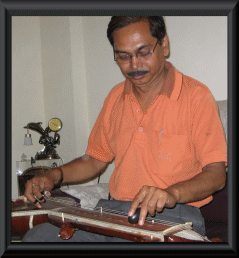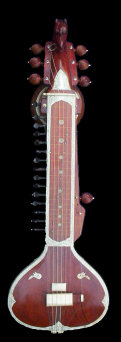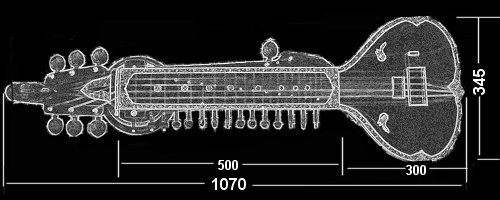A New musical instrument: Ranjan Veena

A New musical instrument: Ranjan Veena
|

|
T. Tuhinanshu |
The wise consider human throat to be a natural Veena. It is counted along with tat, vitat, sushir and avnaddh as those constitutiong the panch-mahavadya (five major instruments). It is the human sound that stimulates the human mind to expriment with other material. He experiments with all possibilities and the results are astounding. Bhoomi-Dundubhi was used during Vedic period and ever since this percussion instrument made out of red-ox hide was created umpteen instruments of all types have evolved. The journey of Indian musical instruments is as perenniel as human civilization. With perfection of Sitar, it seemed that inventions and modifications might rest for some time but Mohan Veena, Shankar Guitar and Ramolin proved that innovations in Indian music are as alive as the music itself.
Before we discuss the invention let us know the inventor. In a family of seven brothers and five sisters, our inventor was the youngest. Niranjan was born in Calcutta to Mahamaya and Dinabandhu Haldar. Both of them came from well-to-do families and were easy-going people well-loved by their neighbors. It was their goodness and supposed wealth that needy people would 'borrow' things like hurricane lamps and bicycles from Haldar's and conveniently 'forget' to return them. The family sufferred after the death of Dinabandhu Haldar and though a few elder children had settled down the younger ones faced a hard life.
When the fifth brother Chittaranjan scraped enough money to buy a guitar, young Niranjan tried his best to get a chance to try out the instrument. It was difficult. Both of them went to school at the sime time and when Niranjan got back home, Chittaranjan too was there.  Even the mother would admonish Niranjan if he touched the guitar when Chittaranjan had gone to play out. So, he had no option but to watch his brother play the instrument. Whenever Chittaranjan was invited to perform, he took the younger brother as caddy for he could not drive the bicycle holding the instrument. One day, the chief guest at the function recognized Chittaranjan as his student. The teacher also noticed the eagerness in the younger boy and after the elder brother had performed asked Niranjan to play. Chittaranjan was amazed by his brother's flawless performance. From now on it was easier for Niranjan who was singing Sandhya Mukherjee songs to delight his friends to begin practice on guitar.
Even the mother would admonish Niranjan if he touched the guitar when Chittaranjan had gone to play out. So, he had no option but to watch his brother play the instrument. Whenever Chittaranjan was invited to perform, he took the younger brother as caddy for he could not drive the bicycle holding the instrument. One day, the chief guest at the function recognized Chittaranjan as his student. The teacher also noticed the eagerness in the younger boy and after the elder brother had performed asked Niranjan to play. Chittaranjan was amazed by his brother's flawless performance. From now on it was easier for Niranjan who was singing Sandhya Mukherjee songs to delight his friends to begin practice on guitar.
In the next phase, Niranjan started giving tutions to pay for his own. He would travel every alternate day to learn guitar with Kazi Nazrul Islam's son Kazi Aniruddha. This continued til 1973 when he began learning with Rajat Nandi. His mother who understood her son's love for music kept a strict check keeping him focused on studies. He did his post graduate diploma in music from Rabindra Bharati in 1978. Niranjan Haldar was performing as a youth artiste in All india Radio since 1972 and in 1980 he was placed in B high grade in Western music - Hawain Guitar. Any one who grows up with Rabindra Sangeet can hardly stay from it. So the next year Niranjan earned a similar placement in Sugam Sangeet category. He had always yearned to play classcial music on the guitar but in Calcutta the very thought was profane. He was spurned by one Guru after other when Pt. Gokul Nag1 moved by his zeal offerred to give lessons.
Niranjan was selected as staff artiste in All India Radio and no one would stop him from playing in his guitar. He was playing western, light and classical music on guitar now but his rejection by a whole generation of sitarist-s rankled his mind. He took up Vichitra Veena. If he excelled in it the taint of being a guitar player would disappear. This ancient Veena had excellent credentials having gained international recognition by recent performers and employed a paying technique quite similar to guitar. Instead of a metallic slider he just had to use a glass ball. Niranjan practiced vigorously and could soon perform on Vichitra Veena. Yet, the joy and ease he found in guitar was missing in this. He did want the sound of Sitar without having to master this instrument.
It was this desire for a certain sound combined with ease of playing that turned performer Niranjan into a researcher. For years he thought about balancing sound with technqiue and turned his home into a carpernter's workshop. He matched metal with wood, plywood with plastic, membrane with clay and their combinations. He thought upon various designs and ways strings could be attached. The result of all this thought and labour was Ranjan Veena.

At first sight, it looks like one of the numerous Indian Veena-s. The uninitated would be surprised on learning that this incarnation of Veena is as recent as 2007.
Omenad is delighted to introduce the latest addition to Indian musical instruments. Although it can be used as accompaniment ot light singing it carries all essentials of a classical instrument. It has bridge, frets and resonators with a range of four octaves. Not because the word rhymes with the name of inventor, but because it means "to please" that this wonderful instrument has been called Ranjan Veena (to hear a sample click here). Niranjan Haldar was enamoured with the sound of Sitar but was hooked equally to guitar. After meditation, consultation with craftsmen and ample experimentation he could finish a bridge instrument that employs the playing technique of slide guitar with Indian strokes to produce Sitar like notes.
The instrument measures 1070 mm in length and is 345 mm wide. It has five main strings with two chikari strings on right and three supportive strings on left. The chikari strings are tuned in Sa-Sa while the supportive strings may be tuned in notes required by a given Raga. It also sports twelve sympathetic strings known as "tarab" which provide resonance. This construction ensures well-rounded tonal quality. A disk-like gourd is placed to balance the main "tumba" so that the instrument can be held in one's lap like a guitar. Inspired by Vichitra Veena, Niranjan decided to settle for its "batta" or glass-ball in place of the usual steel roller. While Vichitra Veena is fretless making it a challenging instrument for the novice, Ranjan Veena has frets like sitar.
The instrument is played with picks on fore-finger, middle-finger and thumb. Thumb opposed to picks provides the essential Ra sound for Da-Ra combination. Embellishments like Krintan, Kana etc. can be produced with two fingers and thumb. There is no denying that Vichitra-Veena like sliding, pulls this instrument nearer to Guitar than Sitar but Niranjan Haldar has invented it to approximate tonal quality of Sitar while maintainng the ease of playing. Anyone conversant with primary technqiues of guitar can master the technique of using fingers and thumb to produce the Da-Ra combination and he is ready to try out indian classical music on Ranjan Veena. Although the instrument achieved its final shape pretty recently, Niranjan Haldar has played several Raga-s on it, e.g. Deshi, Bilaskhani Todi, Madhuvanti, Multani, Bhimpalasi, Brindavani Sarang, Dhani, Basant Mukhari, Yaman, Jog, Darbari Kanhada, Bageshri, Malkauns etc. His performance at Bhopal, Bangalore and Indore has been impressive enough to encourage a few youngsters in expressing their desire to learn this instrument.
There is no denying that Vichitra-Veena like sliding, pulls this instrument nearer to Guitar than Sitar but Niranjan Haldar has invented it to approximate tonal quality of Sitar while maintainng the ease of playing. Anyone conversant with primary technqiues of guitar can master the technique of using fingers and thumb to produce the Da-Ra combination and he is ready to try out indian classical music on Ranjan Veena. Although the instrument achieved its final shape pretty recently, Niranjan Haldar has played several Raga-s on it, e.g. Deshi, Bilaskhani Todi, Madhuvanti, Multani, Bhimpalasi, Brindavani Sarang, Dhani, Basant Mukhari, Yaman, Jog, Darbari Kanhada, Bageshri, Malkauns etc. His performance at Bhopal, Bangalore and Indore has been impressive enough to encourage a few youngsters in expressing their desire to learn this instrument.
Haldar confides, "It was to reduce difficulty of Vichitra Veena and caputre the sound of Tritantri or Jantra (Sitar) that I made Ranjan Veena. Also, those who started with guitar playing western or light music should not feel fear in shifting to Indian music. Their dedication to music and time given in practice should not go waste." They say, necessity is the mother of invention. In the modern world where it is an anchronism to use such terms as western or Chinese, Egyptian or Indian civilization, becuase as Eliot had prophesied, 'all experiences are one' signalling that human civilization stretching as a single string of multiple strands intertwined beyond unravelling, Ranjan Veena is a natural outcome of the need of people to understand things in a manner that suits them. In making this instrument Niranjan Haldar has established that fusion or unification of thought is more important than superficial emulation of behaviour. What Pt. Udaishankar and Ravishankar had contributed towards global appreciation of Indian dance and music, Niranjan's Veena might do to its practice.

1 Father of noted Sitarist Manilal Nag, Pt. Gokul Nag died in 1981.
Inventor's Note : Ranjan Veena
Links:
Excerpts from Bharatiya Sangeet Vadya: Swar-Mandal
Excerpts from Bharatiya Sangeet Vadya: Other Veena-s
Shruti Veena: Manifestation of Bharat’s Gram and ChatuhSarana -- Dr. Lalmani Misra
Contemporary Problems for Indian Music -- Dr. Lalmani Misra
Dr. Lalmani Misra on Wikipedia
Deshi on Ranjan Veena
Ustad Abid Hussain Khan: The Maestro par Excellence
For views of musicians on aspects of music click here
We look forward to your feedback about this new instrument. Please click here to send us your opinion.